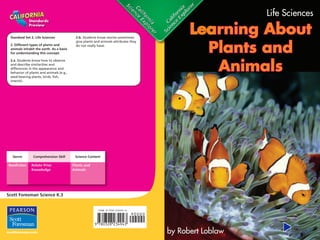K.3 learning about plants and animals (life sciences)
- 1. Standard Set 2. Life Sciences 2. Different types of plants and animals inhabit the earth. As a basis for understanding this concept: 2.a. Students know how to observe and describe similarities and differences in the appearance and behavior of plants and animals (e.g., seed-bearing plants, birds, fish, insects). Genre Comprehension Skill Science Content Nonfi ction Relate Prior Knowledge Plants and Animals Scott Foresman Science K.3 2.b. Students know stories sometimes give plants and animals attributes they do not really have. Standards Preview ISBN 0-328-23494-X ì<(sk$m)=cdejed< +^-Ä-U-Ä-U Life Sciences Learning About Plants and Animals by Robert Loblaw
- 2. Vocabulary animals food need plants real Picture Credits Every effort has been made to secure permission and provide appropriate credit for photographic material. The publisher deeply regrets any omission and pledges to correct errors called to its attention in subsequent editions. Unless otherwise acknowledged, all photographs are the copyright of Dorling Kindersley, a division of Pearson. Photo locators denoted as follows: Top (T), Center (C), Bottom (B), Left (L), Right (R), Background (Bkgd). Opener: Brand X Pictures/Jupiter Images; 4 (TL) Goodshoot, (BL) Getty Images, (TC) Index Open, (BC) SuperStock; 5 (R) Designpics; 6 ┬®Royalty-Free/Corbis; 8 (L) MedioImages/Getty Images, (CR) Stock Connection; 9 (TL) TongRo Image Stock, (R) Image Source/Getty Images; 10 Creatas; 11 (TL) Index Stock Imagery, (TR) Stock Connection, (BL) Image Ideas, (BR) itstock. ISBN: 0-328-23494-X Copyright ┬® Pearson Education, Inc. All Rights Reserved. Printed in the United States of America. This publication is protected by Copyright, and permission should be obtained from the publisher prior to any prohibited reproduction, storage in a retrieval system, or transmission in any form by any means, electronic, mechanical, photocopying, recording, or likewise. For information regarding permission(s), write to Permissions Department, Scott Foresman, 1900 East Lake Avenue, Glenview, Illinois 60025. 1 2 3 4 5 6 7 8 9 10 V010 13 12 11 10 09 08 07 06 Learning About Plants and Animals by Robert Loblaw
- 3. Plants need air. Plants need food and water. 2 3 Plants need soil. Plants need sunlight.
- 4. Animals need air. 4 5 Animals need food and water.
- 5. Plants make their own food where they live. 6 Most animals move to get food. 7
- 6. These plants have seeds. 8 These plants are different sizes. 9
- 7. Animals grow and change. 10 Not all animals move the same. Not all animals look the same. 11
- 8. Real plants and animals do not talk or wear clothes. 12 Good morning! Hello! What did you learn? Relate Prior Knowledge How do animals get food?







